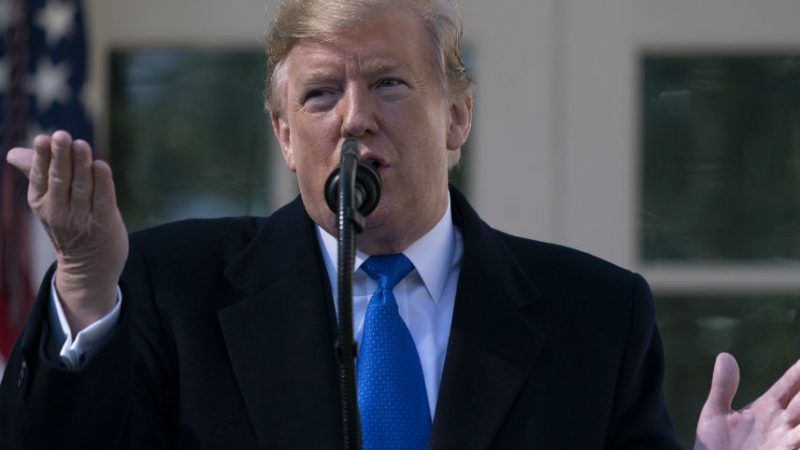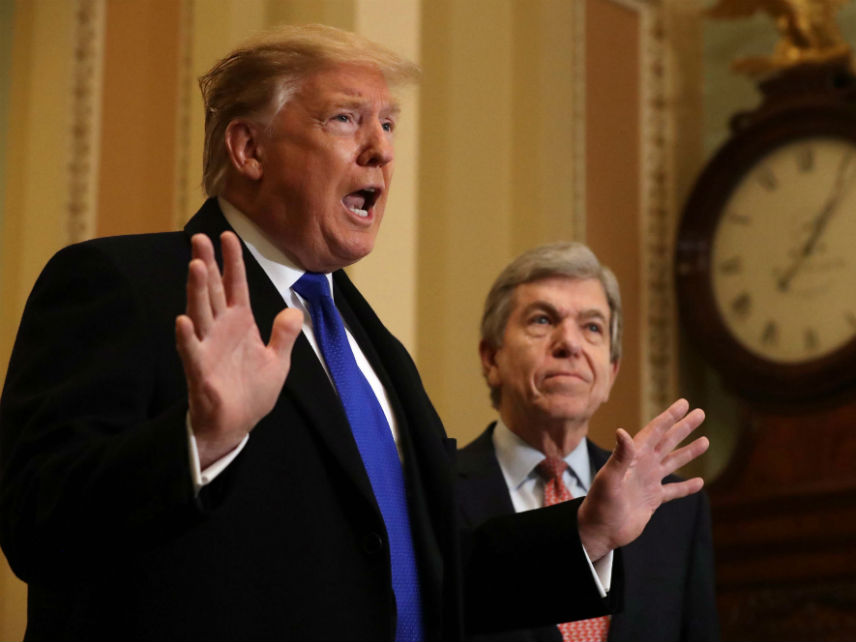Trump Wants To Raid an Asset Forfeiture Black-Box Fund To Build His Border Wall
"Exactly what sources and what individuals this money comes from is obscure, and it's obscure because that's the way the federal government wants it."


President Donald Trump's plan to build a wall along the southern U.S. border will partially rely on the Treasury Department's asset forfeiture fund, according to news reports, but that money comes from a secretive fund potentially rife with civil rights abuses.
Among other sources, the Trump administration reportedly plans to use $600 million from the Treasury Department's Asset Forfeiture Fund, which holds revenues from asset seizures by the Internal Revenue Service (IRS) and agencies under the Department of Homeland Security, such as Customs and Border Protection (CBP) and Immigrations and Customs Enforcement (ICE).
Since 2014, ICE and CBP have seized more than $4 billion worth of property that was allegedly used in crimes, according to government records obtained by Splinter. Among the seized assets were human remains. The Treasury Department's forfeiture fund had a balance of $2.2 billion as of fiscal year 2017.
But it's unclear how many of those cases were criminal forfeitures, in which the property was forfeited after the federal government obtained a criminal conviction against a defendant; and how many were civil forfeitures, wherein the government seized property on the mere suspicion that it was connected to criminal activity.
Unlike the Justice Department, which makes its asset forfeiture database available to the public, the Treasury Department has stonewalled public records requests for its database. In 2016, the Institute for Justice, a libertarian-leaning public interest law firm, filed a Freedom of Information Act lawsuit against the Treasury Department and CBP to obtain their forfeiture databases.
"The federal government is actively trying to conceal detailed information about where this money comes from," says Robert McNamara, a senior attorney at the Institute for Justice. "We have sought it through Freedom of Information Act requests. They have refused to turn it over, and we're in active litigation trying to get our hands on information about where this money comes from."
"The problem with these civil forfeiture cases is the problem with civil forfeiture, which is that it involves taking property without requiring the government to actually prove beyond a reasonable doubt that someone is a criminal," McNamara continues. "Exactly what sources and what individuals this money comes from is obscure, and it's obscure because that's the way the federal government wants it to be."
One such example is the case of Kentucky farmer Geraldo Serrano, whose 2014 Ford F-250 pickup truck was seized by CBP agents after they found five stray bullets in it. CBP attempted to forfeit Serrano's truck under the dubious suspicion that he was involved with international arms smuggling. Serrano, backed by the Institute for Justice, had to fight for two years to get his truck returned, even though he was never charged with a crime.
CBP regularly seizes large amounts of cash at airports, even when there is no evidence of criminal activity. An Albanian immigrant, Rustem Kazazi, who became a U.S. citizen in 2011, sued CBP last year after he was stripped searched and had $58,000 in cash seized from him at a Cleveland airport. Kazazi says he was traveling back to Albania to possibly buy property and converted his savings to cash. CBP claims they suspected Kazazi was involved in drug trafficking or money laundering.
However, the agency failed to file a claim against Kazazi's money within the 90-day deadline, and then failed to return his money after the deadline passed. Last June, the U.S. government agreed to return nearly all of the cash, although Kazazi says it seized $770 more than it claimed.
Civil asset forfeiture has been roundly criticized by civil liberties groups and a wide, bipartisan swath of lawmakers at both the federal and state level because of abuses just like these. More than half of all U.S. states have passed some form of asset forfeiture reform over the last decade in response to similar cases.
A 2017 report by the Treasury Inspector General for Tax Administration (TIGTA) found that, between 2012 and 2014, the IRS seized more than $17 million from innocent business owners using obscure anti-money laundering rules and civil asset forfeiture. The inspector general found money seized and forfeited by the IRS was legally obtained in 91 percent of a sample of 278 structuring investigations it reviewed. As Reason reported:
The investigation was launched in 2014, when media investigations and several lawsuits by the Institute for Justice, a libertarian-leaning public interest law firm, highlighted the cases business owners who had their life savings seized by the IRS for violating anti-"structuring" rules.
The rules are intended to stop money launderers from evading federal banking regulations by making small cash deposits under $10,000, but IRS agents ruthlessly pursued cases against small business owners when there was no other evidence or indication of criminal activity. For example, The New York Times profiled the case of Carol Hinders, an Iowa woman runs a small, cash-only Mexican restaurant. In 2013, two IRS agents showed up at Hinder's door and told her the agency was seizing $33,000 from her bank account for structuring violations. She was never accused of a crime.
In response to public outrage, the IRS announced in 2014 it was changing its asset forfeiture policies to only pursue cases where there is other evidence of criminal activity.
The IRS has previously released some limited data on structuring cases to the Institute for Justice, which leads them to believe the Treasury Department is intentionally stonewalling them.
"We know that they have this information, and we know that they can give it up, but they don't want to give us the entire database," says Jennifer McDonald, a senior research analyst at the Institute for Justice, "which leads us to believe that there is something they don't want us to know about these funds."
Show Comments (34)